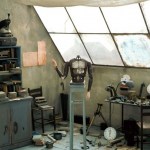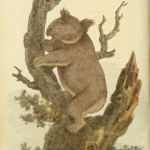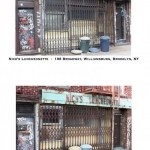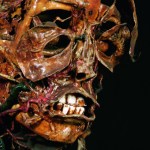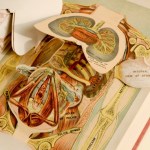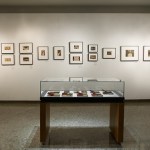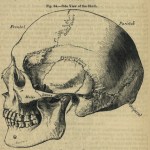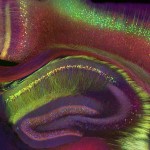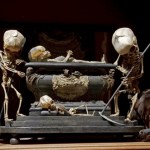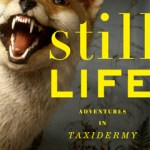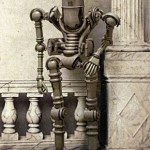Wonder Cabinets
Under glass, a bare forest of pins
held down an army of insects in ragged rows. . .
--"The Expression of Emotion in Man and Insects," by Debora Greger (read the full poem at the Atlantic)
L'Automaton #06, 2010
Paolo Ventura
(zoom view available here)
Artist-photographer Paolo Ventura constructs and photographs miniature, dreamlike scenes. His Winter Stories represent the reminisces of an old circus performer. Above, a scene from the Automaton series captures a mysterious, half-built android. Who is the android's creator? When and where is this happening? Ventura's work is evocative precisely because it is so mysterious. (It turns out that Ventura's backstory for the Automaton series involves a lonely watchmaker in the Jewish ghetto of 1942 Venice - but still, that hardly…
From 1810-11, architect and amateur naturalist George Perry published The Arcana, a lavishly illustrated, serial natural history magazine. Although Perry intended for the serial issues to be assembled by his subscribers into a book, only thirteen complete copies are known to survive today. More than a third of the known copies are in Australia - perhaps fittingly, as Perry was the first to publish an illustration of the koala (above).
Perry's work is not well known; in researching this post, all I could find online were auction listings and occasional references to a recent facsimile…
This little video from Abebooks is the closest I've ever gotten to flipping through a copy of the Codex Seraphinianus. What a truly weird book.
I particularly love it when the staid narrator reveals his "favorite" illustration - a roller skater murdered by a monstrous pen. What?!
The Codex reminds me of If You're Afraid of the Dark, Remember the Night Rainbow by Cooper Edens. My mom had a copy and I used to flip through it as a child, confused and not a little disturbed. I still took things too literally to appreciate the visual non sequiturs, combined with the nonsensical text ("If you…
Nick's Luncheonette
Randy Hage
Via the eye-candy blog How to Be a Retronaut (thanks Miles for first sending me a link there), the painstakingly accurate miniature Manhattan streetscapes of LA artist Randy Hage are half-toy, half-historical document - a wonder cabinet of urban curiosities.
Hage's overarching goal is to preserve rapidly disappearing streetscapes. As he told Jeremiah Moss at Vanishing New York,
I remember one instance in particular that prompted me to seriously focus on this project. I was on my way to revisit a Brooklyn donut shop that I had photographed a year earlier. I…
The most beautiful experience we can have is the mysterious. It is the fundamental emotion which stands at the cradle of true art and true science. Whoever does not know it can no longer wonder, no longer marvel, is as good as dead, and his eyes are dimmed.
Albert Einstein
Ideas and Opinions, New York: Crown, 1954.
(quoted in Lawrence Weschler's Mr. Wilson's Cabinet of Wonder: Pronged Ants, Horned Humans, Mice on Toast, and Other Marvels of Jurassic Technology, New York: Random House, 1995.)
. . . they could have. Or pretty darn close, at least - they just needed to visit one of the many European cabinets of anatomical curiosities, to see the work of anatomists like Honore Fragonard.
Fragonard's eighteenth-century ecorches were the clear precursors to Gunther von Hagens' "Body Worlds" exhibits: preserved, injected, partially dissected bodies in lifelike, dramatic poses, with ragged strips of muscle draped like primitive clothing over exposed vessels and nerves. The effect is eerie - like a Vesalius illustration sprung to (half-)life:
Man with a Mandible
Several of Fragonard's…
Animated Anatomies, a new show at the Perkins Library at Duke University, explores the tradition of fold-out or pop-up paper anatomical diagrams:
Animated Anatomies explores the visually stunning and technically complex genre of printed texts and illustrations known as anatomical flap books. These publications invite the viewer to participate in virtual autopsies, through the process of unfolding their movable leaves, simulating the act of human dissection. This exhibit traces the flap book genre beginning with early examples from the sixteenth century, to the colorful "golden age" of…
Alienation often accounts for a macabre sense of the marvellous. At the entrance to "Savage Beauty," there is an evening gown conjured entirely from razor-clam shells. Antelope horns sprout from the shoulders of a pony-skin jacket, and vulture skulls serve as epaulettes on a leather dress. There are angel wings made out of balsa wood, and worms encased in a bodice of molded plastic. "I'm inspired by a feather," McQueen said of all the duck, turkey, ostrich, and gull plumage in his clothing--"its graphics, its weightlessness, and its engineering."
--Judith Thurman
"Dressed to Thrill," a…
Through the end of May, UMBC's Albin O Kuhn gallery is hosting a large exhibition of postmortem daguerreotypes, death masks, coffin plates, etc. from the collection of Dr. Stanley Burns.
Medical ephemera always have an emotional valence, because they represent patients who suffered, struggled and eventually lost their physical battles. But this collection of memorials are about the survivors' needs, not the dead, and are thus particularly eerie and wrenching.
From the curator:
Trace the evolution of postmortem photography through 19th-century daguerreotypes and prints from Sleeping Beauty…
Thanks to Coilhouse, I just learned that artist Theo Jansen is producing 3D printed baby versions of his amazing strandbeests - wind-powered kinetic sculptures that "walk" on their own.
If you don't remember Jansen, here he is with his eerie, lifelike beests, which he calls "new forms of life:"
Of course you want one, right? Well, now you can get one! A small 3D printed version, at least, without all the wings and propellers. Here's a video of a little strandbeest running around on a string. Give it five seconds, and you won't believe this little guy isn't actually alive:
Squee! (Yes, I'…
Anatomical engraving from Henry Gray's Anatomy, 1858.
A month or so ago, Abrams books reached out to mention that they were releasing a new title, Human Anatomy: A Visual History from the Renaissance to the Digital Age. I said, "don't I already have this book?" It turns out I did - I had the previous, hardback edition which I picked up for $25 or so on Amazon (a deal, I thought at the time). So I knew this book should really be subtitled "vintage eye candy from Vesalius to Schmiedel," because it's a bundle of rich images from anatomical atlases, interspersed with just enough curation to give…
Wait - did Peter Nowogrodski just shoehorn everything I love into one meandering, indulgent multimedia essay??*
Tolkien's Shire appears as a coherent ecosystem, cradled by productive fields and populated by abundant orchards, caches of edible mushroom, and even the fishable Bywater Pool, ornamented with an authentic churning mill. The land at Hobbiton is changing still: Jackson's crowning oak tree now sits in sun-scarred pieces behind a rotten wooden fence at the termination of Bagshot Row, a home for the welcome swallows that course through air above. In the pastures opposite Bag End, a…
Whether you're studying, working, or just trying to stay warm this week, take a moment to appreciate this view of the inner workings of this positively Yeatsian music box:
Mechanical Bird Music Box
I admit it: I burst out laughing at the unexpected closure of the box. Poor little bird! (Yet he rose again, phoenix-like, to sing once more.)
From the collection of the Musical Instrument Museum. Thanks to my friend mdvlst for the link.
In less than a month (December 2nd), Christie's will auction off Edward Tufte's library - an idiosyncratic collection of first edition books, plates, prints, and ephemera that the dataviz guru calls his "Museum of Cognitive Art," and I call "Jessica's Christmas List."
I'm not going to sample low-rez images of the lots here, because there's a stunning slideshow, complete with curation, at the Christie's website. If you've got ten minutes, this is virtual antiquarian dataviz windowshopping at its best.
There appear to be 160 lots; Tufte's website describes it as "200 rare books, including major…
Hippocampus: Broad Overview
Tamily Weissman, Jeff Lichtman, and Joshua Sanes, 2005
from Portraits of the Mind: Visualizing the Brain from Antiquity to the 21st Century by Carl Schoonover
The first time I created a transgenic neuron, it was in a worm, C. elegans -- a tiny, transparent cousin of the earthworm. I injected DNA into the embryonic worm, let it grow up, and voila: there was one eerie green blotch like a little Pac-Man ghost, its long green axon a lime racing stripe running along the worm's transparent body. The worm wiggled, but I was the one hooked: science is beautiful.
You…
Joanna Ebenstein of Morbid Anatomy has just unveiled a new website, the Secret Museum, to house her "exhibition of photographs exploring the poetics of hidden, untouched and curious collections from around the world." So if you can't make it to her show in NYC (through June 6), you can browse her virtual exhibition of photos - like the eerie fetal skeleton tableau above (from Paris, circa 17th century).
This is what I miss out on by not reading the physical copy of the New York Times: ads! I recently picked up a copy of the Times science section and saw an ad for these wonderful vintage patent office models from the 1900s.
As if they're not steampunky enough, each one comes with a little yellowed, handwritten, calligraphic tag that I'm dying to read because I am convinced it must contain cryptic clues to some sort of awesome Neil Stephenson-style mystery. Right??
Here's another interesting summer reading prospect for BioE-philes: Still Life: Adventures in Taxidermy by Melissa Milgrom. From the New York Times review:
The best chapter in "Still Life" by far is the one in which Ms. Milgrom visits with the fascinating and foul-mouthed British artist Emily Mayer, the woman who is Mr. Hirst's taxidermist. She's the woman who, we learn, "repairs the sharks, preserves the grizzlies, assembles the skeletons, and casts the cow heads for his multimillion-dollar artworks." Ms. Mayer is a Tim Burtonesque perfectionist: "I can't have a piece for Damien discolor in…
From Mechanical Brides of the Uncanny by Edward Bateman
In "Mechanical Brides of the Uncanny," artist Edward Bateman creates images that explore photography's role as historical evidence. Presented as a collection of discovered carte de visites, this book documents a forgotten age of mechanical wonders. Carte de visites were an immensely popular form of photography in the last half of the nineteenth century. They were widely traded and collected, with subjects ranging from portraits of everyday people to those of luminaries. Bateman uses this history to question the idea that all…
